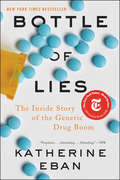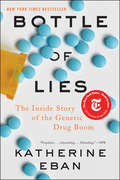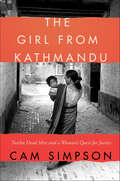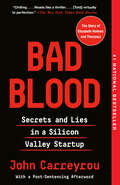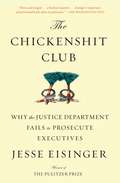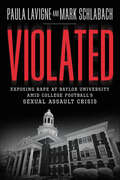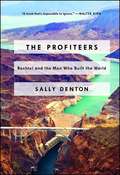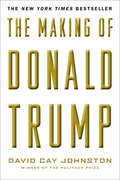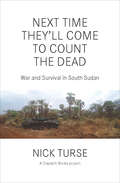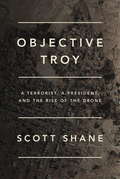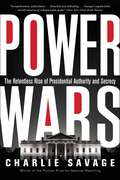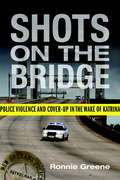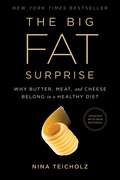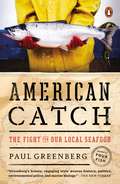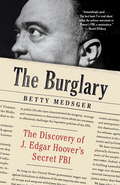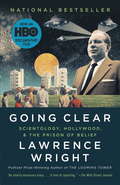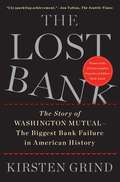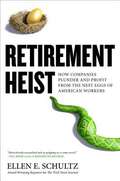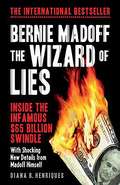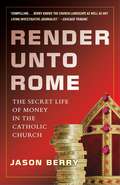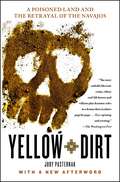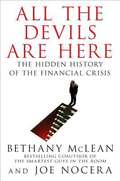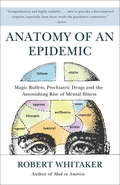Special Collections
Investigative Reporters and Editors Award
Description: The annual IRE Awards recognize outstanding investigative work and help identify the techniques and resources used to complete each story. This collection includes award winners and finalists. #award
- Table View
- List View
Citizen 865
by Debbie CenziperThe gripping story of a team of Nazi hunters at the U.S. Department of Justice as they raced against time to expose members of a brutal SS killing force who disappeared in America after World War Two.In 1990, in a drafty basement archive in Prague, two American historians made a startling discovery: a Nazi roster from 1945 that no Western investigator had ever seen. The long-forgotten document, containing more than 700 names, helped unravel the details behind the most lethal killing operation in World War Two. In the tiny Polish village of Trawniki, the SS set up a school for mass murder and then recruited a roving army of foot soldiers, 5,000 men strong, to help annihilate the Jewish population of occupied Poland. After the war, some of these men vanished, making their way to the U.S. and blending into communities across America. Though they participated in some of the most unspeakable crimes of the Holocaust, "Trawniki Men" spent years hiding in plain sight, their terrible secrets intact.In a story spanning seven decades, Citizen 865 chronicles the harrowing wartime journeys of two Jewish orphans from occupied Poland who outran the men of Trawniki and settled in the United States, only to learn that some of their one-time captors had followed. A tenacious team of prosecutors and historians pursued these men and, up against the forces of time and political opposition, battled to the present day to remove them from U.S. soil. Through insider accounts and research in four countries, this urgent and powerful narrative provides a front row seat to the dramatic turn of events that allowed a small group of American Nazi hunters to hold murderous men accountable for their crimes decades after the war's end.
Bottle of Lies
by Katherine EbanFrom an award-winning journalist, an explosive narrative investigation of the generic drug boom that reveals fraud and life-threatening dangers on a global scale—The Jungle for pharmaceuticalsMany have hailed the widespread use of generic drugs as one of the most important public-health developments of the twenty-first century. Today, almost 90 percent of our pharmaceutical market is comprised of generics, the majority of which are manufactured overseas. We have been reassured by our doctors, our pharmacists and our regulators that generic drugs are identical to their brand-name counterparts, just less expensive. But is this really true?Katherine Eban’s Bottle of Lies exposes the deceit behind generic-drug manufacturing—and the attendant risks for global health. Drawing on exclusive accounts from whistleblowers and regulators, as well as thousands of pages of confidential FDA documents, Eban reveals an industry where fraud is rampant, companies routinely falsify data, and executives circumvent almost every principle of safe manufacturing to minimize cost and maximize profit, confident in their ability to fool inspectors. Meanwhile, patients unwittingly consume medicine with unpredictable and dangerous effects.The story of generic drugs is truly global. It connects middle America to China, India, sub-Saharan Africa and Brazil, and represents the ultimate litmus test of globalization: what are the risks of moving drug manufacturing offshore, and are they worth the savings? A decade-long investigation with international sweep, high-stakes brinkmanship and big money at its core, Bottle of Lies reveals how the world’s greatest public-health innovation has become one of its most astonishing swindles.
Bottle of Lies
by Katherine EbanA NEW YORK TIMES BESTSELLER New York Times 100 Notable Books of 2019New York Public Library Best Books of 2019 Kirkus Reviews Best Health and Science Books of 2019Science Friday Best Books of 2019 New postscript by the authorFrom an award-winning journalist, an explosive narrative investigation of the generic drug boom that reveals fraud and life-threatening dangers on a global scale—The Jungle for pharmaceuticalsMany have hailed the widespread use of generic drugs as one of the most important public-health developments of the twenty-first century. Today, almost 90 percent of our pharmaceutical market is comprised of generics, the majority of which are manufactured overseas. We have been reassured by our doctors, our pharmacists and our regulators that generic drugs are identical to their brand-name counterparts, just less expensive. But is this really true?Katherine Eban’s Bottle of Lies exposes the deceit behind generic-drug manufacturing—and the attendant risks for global health. Drawing on exclusive accounts from whistleblowers and regulators, as well as thousands of pages of confidential FDA documents, Eban reveals an industry where fraud is rampant, companies routinely falsify data, and executives circumvent almost every principle of safe manufacturing to minimize cost and maximize profit, confident in their ability to fool inspectors. Meanwhile, patients unwittingly consume medicine with unpredictable and dangerous effects.The story of generic drugs is truly global. It connects middle America to China, India, sub-Saharan Africa and Brazil, and represents the ultimate litmus test of globalization: what are the risks of moving drug manufacturing offshore, and are they worth the savings? A decade-long investigation with international sweep, high-stakes brinkmanship and big money at its core, Bottle of Lies reveals how the world’s greatest public-health innovation has become one of its most astonishing swindles.
The Girl from Kathmandu
by Cam SimpsonNew York Times Book Review Editor's ChoiceThe shocking story of the massacre of a group of Nepalese men working as Defense contractors for the United States Government during the Iraq War, and the widow who dedicated her life to finding justice for her husband and the other victims—a riveting tale of courageous heroes, corporate war profiteers, international business, exploitation, trafficking, and human rights in the age of global capitalism that reveals how modern power truly works.In August of 2004, twelve men left their village in Nepal for jobs at a five-star luxury hotel in Amman, Jordan. They had no idea that they had actually been hired for sub-contract work on an American military base in Iraq. But fate took an even darker turn when the dozen men were kidnapped and murdered by Islamic extremists. Their gruesome deaths were captured in one of the first graphic execution videos disseminated on the web—the largest massacre of contractors during the war. Compounding the tragedy, their deaths received little notice.Why were these men, from a remote country far removed from the war, in Iraq? How had they gotten there? Who were they working for? Consumed by these questions, award-winning investigative journalist Cam Simpson embarked on a journey to find answers, a decade-long odyssey that would uncover a web of evil spanning the globe—and trigger a chain of events involving one brave young widow, three indefatigable human rights lawyers, and a formidable multinational corporation with deep governmental ties.A heart-rending, page-turning narrative that moves from the Himalayas to the Middle East to Houston and culminates in an epic court battle, The Girl from Kathmandu is a story of death and life—of the war in Iraq, the killings of the twelve Nepalese, a journalist determined to uncover the truth, and a trio of human rights lawyers dedicated to finding justice. At its heart is one unforgettable young woman, Kamala Magar, who found the courage to face the influential men who sent her husband to his death—a model of strength hope, bravery, and an unbreakable spirit who reminds us of the power we all have to make a difference.
Bad Blood
by John CarreyrouThe full inside story of the breathtaking rise and shocking collapse of Theranos, the multibillion-dollar biotech startup, by the prize-winning journalist who first broke the story and pursued it to the end, despite pressure from its charismatic CEO and threats by her lawyers.
In 2014, Theranos founder and CEO Elizabeth Holmes was widely seen as the female Steve Jobs: a brilliant Stanford dropout whose startup "unicorn" promised to revolutionize the medical industry with a machine that would make blood testing significantly faster and easier.
Backed by investors such as Larry Ellison and Tim Draper, Theranos sold shares in a fundraising round that valued the company at more than $9 billion, putting Holmes's worth at an estimated $4.7 billion.
There was just one problem: The technology didn't work.
A riveting story of the biggest corporate fraud since Enron, a tale of ambition and hubris set amid the bold promises of Silicon Valley.
A New York Times Bestseller
The Chickenshit Club
by Jesse EisingerFrom Pulitzer Prize–winning journalist Jesse Eisinger, a blistering account of corporate greed and impunity, and the reckless, often anemic response from the Department of Justice.Why were no bankers put in prison after the financial crisis of 2008? Why do CEOs seem to commit wrongdoing with impunity? The problem goes beyond banks deemed “Too Big to Fail” to almost every large corporation in America—to pharmaceutical companies and auto manufacturers and beyond. The Chickenshit Club—an inside reference to prosecutors too scared of failure and too daunted by legal impediments to do their jobs—explains why. A character-driven narrative, the book tells the story from inside the Department of Justice. The complex and richly reported story spans the last decade and a half of prosecutorial fiascos, corporate lobbying, trial losses, and culture shifts that have stripped the government of the will and ability to prosecute top corporate executives. The book begins in the 1970s, when the government pioneered the notion that top corporate executives, not just seedy crooks, could commit heinous crimes and go to prison. The book travels to trading desks on Wall Street, to corporate boardrooms and the offices of prosecutors and F.B.I agents. These revealing looks provide context for the evolution of the Justice Department’s approach to pursuing corporate criminals through the early aughts and into the Justice Department of today. Exposing one of the most important scandals of our time, The Chickenshit Club provides a clear, detailed explanation as to how our Justice Department has come to avoid, bungle, and mismanage the fight to bring these alleged criminals to justice.
Violated
by Paula Lavigne and Mark SchlabachWritten by ESPN investigative reporters Violated narrates the sexual abuse by members of Baylor's football team and the university's attempt to silence the victims. A portion of the proceeds will be donated to RAINN to help fight sexual abuse.Throughout its history, Baylor University has presented itself as something special: As the world's largest Baptist university, it was unabashedly Christian. It condemned any sex outside of marriage, and drinking alcohol was grounds for dismissal. Students weren't even allowed to dance on campus until 1996. During the last several years, however, Baylor officials were hiding a dark secret: Female students were being sexually assaulted at an alarming rate. Baylor administrators did very little to help victims, and their assailants rarely faced discipline for their abhorrent behavior. Finally, after a pair of high-profile criminal cases involving football players, an independent examination of Baylor's handling of allegations of sexual assault led to sweeping changes, including the unprecedented ouster of its president, athletics director, and popular, highly successful football coach. For several years, campuses and sports teams across the country have been plagued with accusations of sexual violence, and they've been criticized for how they responded to the students involved. But Baylor stands out. A culture reigned in which people believed that any type of sex, especially violent non-consensual sex, simply "doesn't happen here." Yet it was happening. Many people within Baylor's leadership knew about it. And they chose not to act. Paula Lavigne and Mark Schlabach weave together the complex - and at times contradictory - narrative of how a university and football program ascending in national prominence came crashing down amidst the stories of woman after woman coming forward describing their assaults, and a university system they found indifferent to their pain.
The Profiteers
by Sally DentonFrom the bestselling coauthor of The Money and the Power (which the Los Angeles Times called "one of the most important nonfiction books published in a half century")--the inside story of the Bechtel family and the empire they've controlled since the construction of the Hoover Dam.The tale of the Bechtel family dynasty is a classic American business story. It begins with Warren A. "Dad" Bechtel, who led a consortium that constructed the Hoover Dam. From that auspicious start, the family and its eponymous company would go on to "build the world," from the construction of airports in Hong Kong and Doha, to pipelines and tunnels in Alaska and Europe, to mining and energy operations around the globe. Today Bechtel is one of the largest privately held corporations in the world, enriched and empowered by a long history of government contracts and the privatization of public works, made possible by an unprecedented revolving door between its San Francisco headquarters and Washington. Bechtel executives John McCone, Caspar Weinberger, and George P. Shultz segued from leadership at the company to positions as Director of the CIA, Secretary of Defense, and Secretary of State, respectively. Like all stories of empire building, the rise of Bechtel presents a complex and riveting narrative. In The Profiteers, Sally Denton, whom The New York Times called "a wonderful writer," exposes Bechtel's secret world and one of the biggest business and political stories of our time.
The Making of Donald Trump
by David Cay JohnstonThe culmination of nearly 30 years of reporting on Donald Trump, Pulitzer Prize-winning investigative reporter, David Cay Johnston, takes a revealingly close look at the mogul's rise to power and prominence.
Covering the long arc of Trump's career, Johnston tells the full story of how a boy from a quiet section of Queens, NY would become an entirely new, and complex, breed of public figure. Trump is a man of great media savvy, entrepreneurial spirit, and political clout. Yet his career has been plagued by legal troubles and mounting controversy.
From the origins of his family's real estate fortune, to his own too-big-to-fail business empire; from his education and early career, to his whirlwind presidential bid, The Making of Donald Trump provides the fullest picture yet of Trump's extraordinary ascendency. Love him or hate him, Trump's massive influence is undeniable, and figures as diverse as Woody Guthrie (who wrote a scathing song about Trump's father) and Red Scare prosecutor Roy Cohn, mob bosses and high rollers, as well as the average American voter, have all been pulled into his orbit.
Drawing on decades of interviews, financial records, court documents, and public statements, David Cay Johnston, who has covered Trump more closely than any other journalist working today, gives us the most in-depth look yet at the man who would be president.
A New York Times Bestseller
Objective Troy
by Scott ShaneObjective Troy tells the gripping and unsettling story of Anwar al-Awlaki, the once-celebrated American imam who called for moderation after 9/11, a man who ultimately directed his outsized talents to the mass murder of his fellow citizens. It follows Barack Obama's campaign against the excesses of the Bush counterterrorism programs and his eventual embrace of the targeted killing of suspected militants. And it recounts how the president directed the mammoth machinery of spy agencies to hunt Awlaki down in a frantic, multi-million-dollar pursuit that would end with the death of Awlaki by a bizarre, robotic technology that is changing warfare--the drone. Scott Shane, who has covered terrorism for The New York Times over the last decade, weaves the clash between president and terrorist into both a riveting narrative and a deeply human account of the defining conflict of our era. Awlaki, who directed a plot that almost derailed Obama's presidency, and then taunted him from his desert hideouts, will go down in history as the first United States citizen deliberately hunted and assassinated by his own government without trial. But his eloquent calls to jihad, amplified by YouTube, continue to lure young Westerners into terrorism--resulting in tragedies from the Boston marathon bombing to the murder of cartoonists at a Paris weekly. Awlaki's life and death show how profoundly America has been changed by the threat of terrorism and by our own fears. Illuminating and provocative, and based on years of in depth reporting, Objective Troy is a brilliant reckoning with the moral challenge of terrorism and a masterful chronicle of our times.From the Hardcover edition.
Power Wars
by Charlie SavagePulitzer Prize-winning journalist Charlie Savage's penetrating investigation of the Obama presidency and the national security stateBarack Obama campaigned on a promise of change from George W. Bush's "global war on terror." Yet from indefinite detention and drone strikes to surveillance and military tribunals, Obama ended up continuing-and in some cases expanding-many policies he inherited. What happened? In Power Wars, Charlie Savage looks inside the Obama administration's national security legal and policy team in a way that no one has before. Based on exclusive interviews with more than 150 current and former officials and access to previously unreported documents, he lays bare their internal deliberations, including emotional debates over the fates of detainees held on torture-tainted evidence and acts of war that lacked congressional authorization. He tells the inside stories of how Obama came to order the killing of an American citizen, preside over an unprecedented crackdown on leaks, and keep a then-secret National Security Agency program that collected records of every American's phone calls.Savage also pieces together the first comprehensive history of how American surveillance secretly developed over the past thirty-five years, synthesizing recent revelations and filling in gaps with new reporting. And he provides lucid explanations of legal dilemmas in a way that non-lawyers can understand. Highlighted by new information about the pivotal aftermath to the failed Christmas underwear bombing and the planning for the Osama bin Laden raid, Savage's own eyewitness reporting at Guantánamo, and detailed accounts of closed-door meetings at the highest levels of government, Power Wars equips readers to understand the legacy of Obama's presidency.
Shots on the Bridge
by Ronnie GreeneA harrowing story of blue on black violence, of black lives that seemingly did not matter.On September 4, 2005, six days after Hurricane Katrina's landfall in New Orleans, two groups of people intersected on the Danziger Bridge, a low-rising expanse over the Industrial Canal. One was the police who had stayed behind as Katrina roared near, desperate to maintain control as their city spun into chaos. The other was the residents forced to stay behind with them during the storm and, on that fateful Sunday, searching for the basics of survival: food, medicine, security. They collided that morning in a frenzy of gunfire.When the shooting stopped, a gentle forty-year-old man with the mind of a child lay slumped on the ground, seven bullet wounds in his back, his white shirt turned red. A seventeen-year-old was riddled with gunfire from his heel to his head. A mother's arm was blown off; her daughter's stomach gouged by a bullet. Her husband's head was pierced by shrapnel. Her nephew was shot in the neck, jaw, stomach, and hand. Like all the other victims, he was black--and unarmed.Before the blood had dried on the pavement, the shooters, each a member of the New Orleans Police Department, and their supervisors hatched a cover-up. They planted a gun, invented witnesses, and charged two of their victims with attempted murder. At the NOPD, they were hailed as heroes. Shots on the Bridge explores one of the most dramatic cases of police violence seen in our country in the last decade--the massacre of innocent people, carried out by members of the NOPD, in the brutal, disorderly days following Hurricane Katrina. It reveals the fear that gripped the police of a city slid into anarchy, the circumstances that drove desperate survivors to the bridge, and the horror that erupted when the police opened fire. It carefully unearths the cover-up that nearly buried the truth. And finally, it traces the legal maze that, a decade later, leaves the victims and their loved ones still searching for justice. This is the story of how the people meant to protect and serve citizens can do violence, hide their tracks, and work the legal system as the nation awaits justice.From the Hardcover edition.
The Big Fat Surprise
by Nina TeicholzA New York Times bestseller Named one of The Economist's Books of the Year 2014 Named one of The Wall Street Journal's Top Ten Best Nonfiction Books of 2014 Kirkus Reviews Best Nonfiction Books of 2014 Forbes's Most Memorable Healthcare Book of 2014 In The Big Fat Surprise, investigative journalist Nina Teicholz reveals the unthinkable: that everything we thought we knew about dietary fat is wrong. She documents how the low-fat nutrition advice of the past sixty years has amounted to a vast uncontrolled experiment on the entire population, with disastrous consequences for our health.For decades, we have been told that the best possible diet involves cutting back on fat, especially saturated fat, and that if we are not getting healthier or thinner it must be because we are not trying hard enough. But what if the low-fat diet is itself the problem? What if the very foods we've been denying ourselves--the creamy cheeses, the sizzling steaks--are themselves the key to reversing the epidemics of obesity, diabetes, and heart disease? In this captivating, vibrant, and convincing narrative, based on a nine-year-long investigation, Teicholz shows how the misinformation about saturated fats took hold in the scientific community and the public imagination, and how recent findings have overturned these beliefs. She explains why the Mediterranean Diet is not the healthiest, and how we might be replacing trans fats with something even worse. This startling history demonstrates how nutrition science has gotten it so wrong: how overzealous researchers, through a combination of ego, bias, and premature institutional consensus, have allowed dangerous misrepresentations to become dietary dogma. With eye-opening scientific rigor, The Big Fat Surprise upends the conventional wisdom about all fats with the groundbreaking claim that more, not less, dietary fat--including saturated fat--is what leads to better health and wellness. Science shows that we have been needlessly avoiding meat, cheese, whole milk, and eggs for decades and that we can now, guilt-free, welcome these delicious foods back into our lives.
American Catch
by Paul GreenbergINVESTIGATIVE REPORTERS & EDITORS Book Award, Finalist 2014
In American Catch, award-winning author Paul Greenberg takes the same skills that won him acclaim in Four Fish to uncover the tragic unraveling of the nation's seafood supply--telling the surprising story of why Americans stopped eating from their own waters. In 2005, the United States imported five billion pounds of seafood, nearly double what we imported twenty years earlier. Bizarrely, during that same period, our seafood exports quadrupled.
American Catch examines New York oysters, Gulf shrimp, and Alaskan salmon to reveal how it came to be that 91 percent of the seafood Americans eat is foreign. In the 1920s, the average New Yorker ate six hundred local oysters a year. Today, the only edible oysters lie outside city limits. Following the trail of environmental desecration, Greenberg comes to view the New York City oyster as a reminder of what is lost when local waters are not valued as a food source. Farther south, a different catastrophe threatens another seafood-rich environment.
When Greenberg visits the Gulf of Mexico, he arrives expecting to learn of the Deepwater Horizon oil spill's lingering effects on shrimpers, but instead finds that the more immediate threat to business comes from overseas. Asian-farmed shrimp--cheap, abundant, and a perfect vehicle for the frying and sauces Americans love--have flooded the American market. Finally, Greenberg visits Bristol Bay, Alaska, home to the biggest wild sockeye salmon run left in the world. A pristine, productive fishery, Bristol Bay is now at great risk: The proposed Pebble Mine project could under¬mine the very spawning grounds that make this great run possible. In his search to discover why this precious renewable resource isn't better protected, Green¬berg encounters a shocking truth: the great majority of Alaskan salmon is sent out of the country, much of it to Asia. Sockeye salmon is one of the most nutritionally dense animal proteins on the planet, yet Americans are shipping it abroad.
Despite the challenges, hope abounds. In New York, Greenberg connects an oyster restoration project with a vision for how the bivalves might save the city from rising tides. In the Gulf, shrimpers band together to offer local catch direct to consumers. And in Bristol Bay, fishermen, environmentalists, and local Alaskans gather to roadblock Pebble Mine. With American Catch, Paul Greenberg proposes a way to break the current destructive patterns of consumption and return American catch back to American eaters.
The Burglary
by Betty MedsgerThe never-before-told full story of the 1971 history-changing break-in of the FBI offices in Media, Pennsylvania, by a group of unlikely activists--quiet, ordinary, hardworking Americans--that made clear the shocking truth and confirmed what some had long suspected, that J. Edgar Hoover had created and was operating his own shadow Bureau of Investigation.The book shows how the break-in, and subsequent release of the contents of the FBI's files to newspapers across the country, upended the public's perception of the up-till-then inviolate head of the Bureau, paving the way for the FBI's overhaul for the first time since its inception forty-seven years before, in 1924, and setting the stage for the sensational release three months later by Daniel Ellsberg of the top-secret seven-thousand-page Pentagon study of U.S. decision making regarding the Vietnam War that became known as the Pentagon Papers.
Going Clear
by Lawrence WrightA clear-sighted revelation, a deep penetration into the world of Scientology by the Pulitzer Prize-winning author of The Looming Tower, the now-classic study of al-Qaeda's 9/11 attack. Based on more than two hundred personal interviews with current and former Scientologists--both famous and less well known--and years of archival research, Lawrence Wright uses his extraordinary investigative ability to uncover for us the inner workings of the Church of Scientology.At the book's center, two men whom Wright brings vividly to life, showing how they have made Scientology what it is today: The darkly brilliant science-fiction writer L. Ron Hubbard, whose restless, expansive mind invented a new religion. And his successor, David Miscavige--tough and driven, with the unenviable task of preserving the church after the death of Hubbard.We learn about Scientology's complicated cosmology and special language. We see the ways in which the church pursues celebrities, such as Tom Cruise and John Travolta, and how such stars are used to advance the church's goals. And we meet the young idealists who have joined the Sea Org, the church's clergy, signing up with a billion-year contract.In Going Clear, Wright examines what fundamentally makes a religion a religion, and whether Scientology is, in fact, deserving of this constitutional protection. Employing all his exceptional journalistic skills of observation, understanding, and shaping a story into a compelling narrative, Lawrence Wright has given us an evenhanded yet keenly incisive book that reveals the very essence of what makes Scientology the institution it is.From the Hardcover edition.
The American Way of Eating
by Tracie McmillanWhat if you can't afford nine-dollar tomatoes? That was the question award-winning journalist Tracie McMillan couldn't escape as she watched the debate about America's meals unfold, one that urges us to pay food's true cost--which is to say, pay more. So in 2009 McMillan embarked on a groundbreaking undercover journey to see what it takes to eat well in America. For nearly a year, she worked, ate, and lived alongside the working poor to examine how Americans eat when price matters. From the fields of California, a Walmart produce aisle outside of Detroit, and the kitchen of a New York City Applebee's, McMillan takes us into the heart of America's meals. With startling intimacy she portrays the lives and food of Mexican garlic crews, Midwestern produce managers, and Caribbean line cooks, while also chronicling her own attempts to live and eat on meager wages. Along the way, she asked the questions still facing America a decade after the declaration of an obesity epidemic: Why do we eat the way we do? And how can we change it? To find out, McMillan goes beyond the food on her plate to examine the national prio-rities that put it there. With her absorbing blend of riveting narrative and formidable investigative reporting, McMillan takes us from dusty fields to clanging restaurant kitchens, linking her work to the quality of our meals--and always placing her observations in the context of America's approach not just to farms and kitchens but to wages and work. The surprising answers that McMillan found on her journey have profound implications for our food and agriculture, and also for how we see ourselves as a nation. Through stunning reportage, Tracie McMillan makes the simple case that--city or country, rich or poor--everyone wants good food. Fearlessly reported and beautifully written, The American Way of Eating goes beyond statistics and culture wars to deliver a book that is fiercely intelligent and compulsively readable. Talking about dinner will never be the same again.
The Lost Bank
by Kirsten GrindDuring the most dizzying days of the financial crisis, Washington Mutual, a bank with hundreds of billions of dollars in its coffers, suffered a crippling bank run. The story of its final, brutal collapse in the autumn of 2008, and its controversial sale to JPMorgan Chase, is an astonishing account of how one bank lost itself to greed and mismanagement, and how the entire financial industry--and even the entire country-- lost its way as well. Kirsten Grind's The Lost Bank is a magisterial and gripping account of these events, tracing the cultural shifts, the cockamamie financial engineering, and the hubris and avarice that made this incredible story possible. The men and women who become the central players in this tragedy-- the regulators and the bankers, the home buyers and the lenders, the number crunchers and the shareholders--are heroes and villains, perpetrators and victims, often switching roles with one another as the drama unfolds. As a reporter at the time for the Puget Sound Business Journal, Grind covered a story set far from the epicenters of finance and media. It happened largely in places such as the suburban homes of central California and the office buildings of Seattle, but Grind covered the story from the beginning, and the clarity and persistence of her reporting earned her many awards, including being named a finalist for the Pulitzer Prize and the Gerald Loeb Award. She takes readers into boardrooms and bedrooms, revealing the power struggles that pitted regulators at the Office of Thrift Supervision and the FDIC against one another and the predatory negotiations of investment bankers and lawyers who enriched themselves during the bank's rise and then devoured the decimated bank in its final days. Written as compellingly as the finest fiction, The Lost Bank makes it clear that the collapse of Washington Mutual was not just the largest bank failure in American history. It is a story of talismanic qualities, reflecting the incredible rise and the precipitous collapse of not only an institution but of trust, fortunes, and the marketplaces for risk across the world.
Retirement Heist
by Ellen E. SchultzIt's no secret that hundreds of companies have been slashing pensions and health coverage earned by millions of retirees. Employers blame an aging workforce, stock market losses, and spiraling costs-a perfect storm of external forces that has forced them to take drastic measures. But this so-called retirement crisis is no accident. Award-winning investigative reporter Ellen E. Schultz reveals how large companies and the retirement industry-benefits consultants, insurance companies, and banks-have all played a huge, hidden role in the death spiral of American pensions and benefits. A little over a decade ago, most companies had more than enough set aside to pay the benefits earned by two generations of workers, no matter how long they lived. But by exploiting loopholes, ambiguous regulations, and new accounting rules, companies essentially turned their pension plans into piggy banks, tax shelters, and profit centers. Drawing on original analysis of company data, government filings, confidential memos, and more, Schultz uncovers decades of deception during which employers have exaggerated their retiree burdens while lobbying for government handouts, secretly cutting pensions, tricking employees, and misleading shareholders. She reveals how companies siphon billions of dollars from their pension plans to finance downsizings and sell the assets in merger deals; overstate the burden of rank-and-file retiree obligations to justify benefits cuts while using the savings to inflate executive pay and pensions; hide their growing executive pension liabilities, which at some companies now exceed the liabilities for the regular pension plans; purchase billions of dollars of life insurance on workers and use the policies as informal executive pension funds; preemptively sue retirees after cutting retiree health benefits and use other legal strategies to erode their legal protections. This is a scathing exposé of one of the most critical and least understood crises of our time.
Bernie Madoff, the Wizard of Lies
by Diana B. HenriquesBased on award-winning reporter Diana Henriques' unprecedented access to Madoff, including extensive correspondence and his first interviews for publication since his arrest, "Bernie Madoff, The Wizard of Lies" is the ultimate true-life financial thriller.
Render Unto Rome
by Jason BerryAN INVESTIGATION OF EPIC FINANCIAL INTRIGUE, RENDER UNTO ROME EXPOSES THE SECRECY AND DECEIT THAT RUN COUNTER TO THE VALUES OF THE CATHOLIC CHURCH.The Sunday collection in every Catholic church throughout the world is as familiar a part of the Mass as the homily and even Communion. There is no doubt that historically the Catholic Church has been one of the great engines of charity in history. But once a dollar is dropped in that basket, where does it go? How are weekly cash contributions that can amount to tens of thousands of dollars accounted for? Where does the money go when a diocese sells a church property for tens of millions of dollars? And what happens when hundreds of millions of dollars are turned over to officials at the highest ranks, no questions asked, for their discretionary use? The Roman Catholic Church is the largest organization in the world. The Vatican has never revealed its net worth, but the value of its works of art, great churches, property in Rome, and stocks held through its bank easily run into the tens of billions. Yet the Holy See as a sovereign state covers a mere 108 acres and has a small annual budget of about $280 million.No major book has examined the church's financial underpinnings and practices with such journalistic force. Today the church bears scrutiny by virtue of the vast amounts of money (nearly $2 billion in the United States alone) paid out to victims of clergy abuse. Amid mounting diocesan bankruptcies, bishops have been selling off whole pieces of the infrastructure--churches, schools, commercial properties--while the nephew of one of the Vatican's most powerful cardinals engaged in a lucrative scheme to profiteer off the enormous downsizing of American church wealth.From the Hardcover edition.
Yellow Dirt
by Judy PasternakWINNER OF THE J. ANTHONY LUKAS WORK-IN-PROGRESS AWARD Atop a craggy mesa in the northern reaches of the Navajo reservation lies what was once a world-class uranium mine called Monument No. 2. Discovered in the 1940s--during the government's desperate press to build nuclear weapons--the mesa's tremendous lode would forever change the lives of the hundreds of Native Americans who labored there and of their families, including many who dwelled in the valley below for generations afterward. Yellow Dirt offers readers a window into a dark chapter of modern history that still reverberates today. From the 1940s into the early twenty-first century, the United States knowingly used and discarded an entire tribe for the sake of atomic bombs. Secretly, during the days of the Manhattan Project and then in a frenzy during the Cold War, the government bought up all the uranium that could be mined from the hundreds of rich deposits entombed under the sagebrush plains and sandstone cliffs. Despite warnings from physicians and scientists that long-term exposure could be harmful, even fatal, thousands of miners would work there unprotected. A second set of warnings emerged about the environmental impact. Yet even now, long after the uranium boom ended, and long after national security could be cited as a consideration, many residents are still surrounded by contaminated air, water, and soil. The radioactive "yellow dirt" has ended up in their drinking supplies, in their walls and floors, in their playgrounds, in their bread ovens, in their churches, and even in their garbage dumps. And they are still dying. Transporting readers into a little-known country-within-a-country, award-winning journalist Judy Pasternak gives rare voice to Navajo perceptions of the world, their own complicated involvement with uranium mining, and their political coming-of-age. Along the way, their fates intertwine with decisions made in Washington, D.C., in the Navajo capital of Window Rock, and in the Western border towns where swashbuckling mining men trained their sights on the fortunes they could wrest from tribal land, successfully pressuring the government into letting them do it their way. Yellow Dirt powerfully chronicles both a scandal of neglect and the Navajos' long fight for justice. Few had heard of this shameful legacy until Pasternak revealed it in a prize-winning Los Angeles Times series that galvanized a powerful congressman and a famous prosecutor to press for redress and repair of the grievous damage. In this expanded account, she provides gripping new details, weaving the personal and the political into a tale of betrayal, of willful negligence, and, ultimately, of reckoning.
All the Devils Are Here
by Bethany Mclean and Joe Nocera"Hell is empty, and all the devils are here." -Shakespeare, The TempestAs soon as the financial crisis erupted, the finger-pointing began. Should the blame fall on Wall Street, Main Street, or Pennsylvania Avenue? On greedy traders, misguided regulators, sleazy subprime companies, cowardly legislators, or clueless home buyers?According to Bethany McLean and Joe Nocera, two of America's most acclaimed business journalists, the real answer is all of the above-and more. Many devils helped bring hell to the economy. And the full story, in all of its complexity and detail, is like the legend of the blind men and the elephant. Almost everyone has missed the big picture. Almost no one has put all the pieces together.All the Devils Are Here goes back several decades to weave the hidden history of the financial crisis in a way no previous book has done. It explores the motivations of everyone from famous CEOs, cabinet secretaries, and politicians to anonymous lenders, borrowers, analysts, and Wall Street traders. It delves into the powerful American mythology of homeownership. And it proves that the crisis ultimately wasn't about finance at all; it was about human nature.Among the devils you'll meet in vivid detail:* Angelo Mozilo, the CEO of Countrywide, who dreamed of spreading homeownership to the masses, only to succumb to the peer pressure-and the outsized profits-of the sleaziest subprime lending.* Roland Arnall, a respected philanthropist and diplomat, who made his fortune building Ameriquest, a subprime lending empire that relied on blatantly deceptive lending practices.* Hank Greenberg, who built AIG into a Rube Goldberg contraption with an undeserved triple-A rating, and who ran it so tightly that he was the only one who knew where all the bodies were buried.* Stan O'Neal of Merrill Lynch, aloof and suspicious, who suffered from "Goldman envy" and drove a proud old firm into the ground by promoting cronies and pushing out his smartest lieutenants.* Lloyd Blankfein, who helped turn Goldman Sachs from a culture that famously put clients first to one that made clients secondary to its own bottom line.* Franklin Raines of Fannie Mae, who (like his predecessors) bullied regulators into submission and let his firm drift away from its original, noble mission.* Brian Clarkson of Moody's, who aggressively pushed to increase his rating agency's market share and stock price, at the cost of its integrity.* Alan Greenspan, the legendary maestro of the Federal Reserve, who ignored the evidence of a growing housing bubble and turned a blind eye to the lending practices that ultimately brought down Wall Street-and inflicted enormous pain on the country.Just as McLean's The Smartest Guys in the Room was hailed as the best Enron book on a crowded shelf, so will All the Devils Are Here be remembered for finally making sense of the meltdown and its consequences.
Anatomy of an Epidemic
by Robert WhitakerIn this astonishing and startling book, award-winning science and history writer Robert Whitaker investigates a medical mystery: Why has the number of disabled mentally ill in the United States tripled over the past two decades? Every day, 1,100 adults and children are added to the government disability rolls because they have become newly disabled by mental illness, with this epidemic spreading most rapidly among our nation’s children. What is going on?
Anatomy of an Epidemic challenges readers to think through that question themselves. First, Whitaker investigates what is known today about the biological causes of mental disorders. Do psychiatric medications fix “chemical imbalances” in the brain, or do they, in fact, create them? Researchers spent decades studying that question, and by the late 1980s, they had their answer. Readers will be startled—and dismayed—to discover what was reported in the scientific journals.
Then comes the scientific query at the heart of this book: During the past fifty years, when investigators looked at how psychiatric drugs affected long-term outcomes, what did they find? Did they discover that the drugs help people stay well? Function better? Enjoy good physical health? Or did they find that these medications, for some paradoxical reason, increase the likelihood that people will become chronically ill, less able to function well, more prone to physical illness?
This is the first book to look at the merits of psychiatric medications through the prism of long-term results. Are long-term recovery rates higher for medicated or unmedicated schizophrenia patients? Does taking an antidepressant decrease or increase the risk that a depressed person will become disabled by the disorder? Do bipolar patients fare better today than they did forty years ago, or much worse? When the National Institute of Mental Health (NIMH) studied the long-term outcomes of children with ADHD, did they determine that stimulants provide any benefit?
By the end of this review of the outcomes literature, readers are certain to have a haunting question of their own: Why have the results from these long-term studies—all of which point to the same startling conclusion—been kept from the public?
In this compelling history, Whitaker also tells the personal stories of children and adults swept up in this epidemic. Finally, he reports on innovative programs of psychiatric care in Europe and the United States that are producing good long-term outcomes. Our nation has been hit by an epidemic of disabling mental illness, and yet, as Anatomy of an Epidemic reveals, the medical blueprints for curbing that epidemic have already been drawn up.

